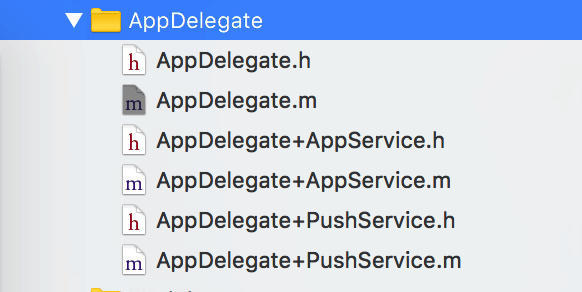Bugly 官网
腾讯 Bugly,为移动开发者提供专业的异常上报和运营统计,帮助开发者快速发现并解决异常,同时掌握产品运营动态,及时跟进用户反馈。
最近 iOS 项目中集成了 Bugly ,集成该框架的过程中,90% 的问题通过仔细阅读 Bugly 官方文档 都可以解决。
💡 本文并不会教你如何注册申请 Bugly 帐号,也不会教你如何集成 Bugly SDK,因为官方文档是最权威的,这里只是记录几个注意点(传说中的坑!)。
初始化 Bugly 的注意点
方式一,最简单
在工程 AppDelegate.m 的 application:didFinishLaunchingWithOptions: 方法中初始化:
#import "AppDelegate.h"
#import <Bugly/Bugly.h>
// Bugly 帐号中创建产品后,产品信息中的 AppId
static NSString *const KBuglyAppId = @"**********";
@implementation AppDelegate
- (BOOL)application:(UIApplication *)application didFinishLaunchingWithOptions:(NSDictionary *)launchOptions {
[Bugly startWithAppId:KBuglyAppId];
return YES;
}方式二,官方文档中的” 高级功能”
Bugly 支持读取 Info.plist 文件读取 SDK 初始化参数,可配置的参数如下:
- Appid
- Key: BuglyAppIDString
- Value: 字符串类型
- 渠道标识
- Key: BuglyAppChannelString
- Value: 字符串类型
- 版本信息
- Key: BuglyAppVersionString
- Value: 字符串类型
- 开启Debug信息显示
- Key: BuglyDebugEnable
- Value: BOOL类型我们设置 Info.plist 文件如下:

如下初始化方式,则会读取 Info.plist 内添加的 key-value 配置进行 SDK 初始化:
- (BOOL)application:(UIApplication *)application didFinishLaunchingWithOptions:(NSDictionary *)launchOptions {
// 读取Info.plist中的参数初始化SDK
[Bugly startWithAppId:nil];
return YES;
}以上方式初始化 Bugly 确实没问题,可是默认的 BuglyConfig 还有几个监控开关没开,我也想顺便开启一下:
// 可能存在问题的代码
- (BOOL)application:(UIApplication *)application didFinishLaunchingWithOptions:(NSDictionary *)launchOptions {
BuglyConfig *config = [[BuglyConfig alloc] init];
config.blockMonitorEnable = YES; // 卡顿监控开关,默认关闭
config.blockMonitorTimeout = 5;
config.unexpectedTerminatingDetectionEnable = YES; // 非正常退出事件记录开关,默认关闭
// 读取Info.plist中的参数初始化SDK
[Bugly startWithAppId:nil config:config];
return YES;
}⚠️ 注意,这样初始化就会有问题,如果配置了 Info.plist 字段,又在初始化时传入了自定义的 BuglyConfig 实例,那么在 Info.plist 中配置的 BuglyAppChannelString、BuglyAppVersionString、BuglyDebugEnable 会因为被覆盖而失效。
方式三,自定义配置
如果需要自定义配置 BuglyConfig 实例,这里就不建议不同时配置 Info.plist 字段(或者可以只配置 BuglyAppIDString 字段):
完整代码:
#import "AppDelegate.h"
#import <Bugly/Bugly.h>
static NSString *const KBuglyAppId = @"**********";
@implementation AppDelegate
#pragma mark - UIApplicationDelegate
- (BOOL)application:(UIApplication *)application didFinishLaunchingWithOptions:(NSDictionary *)launchOptions {
[self p_configureForBugly];
return YES;
}
#pragma mark - Private
- (void)p_configureForBugly {
BuglyConfig *config = [[BuglyConfig alloc] init];
config.channel = @"App Store";
config.blockMonitorEnable = YES; // 卡顿监控开关,默认关闭
config.blockMonitorTimeout = 5;
config.unexpectedTerminatingDetectionEnable = YES; // 非正常退出事件记录开关,默认关闭
config.delegate = self;
#ifdef DEBUG
config.debugMode = YES; // debug 模式下,开启调试模式
config.reportLogLevel = BuglyLogLevelVerbose; // 设置打印日志级别
#else
config.debugMode = NO; // release 模式下,关闭调试模式
config.reportLogLevel = BuglyLogLevelWarn; // 设置自定义日志上报的级别,默认不上报自定义日志
#endif
[Bugly startWithAppId:KBuglyAppId config:config];
}⚠️ 如果你配置完 Bugly 之后,
BLYLogError(fmt, ...)
BLYLogWarn(fmt, ...)
BLYLogInfo(fmt, ...)
BLYLogDebug(fmt, ...)
BLYLogVerbose(fmt, ...)如上的日志不会在控制台输出,或者部分类型日志不会输出,那你应该注意到需要设置这段代码:
#ifdef DEBUG
config.debugMode = YES; // debug 模式下,开启调试模式
config.reportLogLevel = BuglyLogLevelVerbose; // 设置打印日志级别
#else
config.debugMode = NO; // release 模式下,关闭调试模式
config.reportLogLevel = BuglyLogLevelWarn; // 设置自定义日志上报的级别,默认不上报自定义日志
#endif关于 SDK 回调问题
BuglyConfig.h 文件中还有一个可以遵守的协议 BuglyDelegate 用于在系统崩溃时可以同时上传自定义数据。
@protocol BuglyDelegate <NSObject>
@optional
/**
* 发生异常时回调
*
* @param exception 异常信息
*
* @return 返回需上报记录,随异常上报一起上报
*/
- (NSString * BLY_NULLABLE)attachmentForException:(NSException * BLY_NULLABLE)exception;
@end我遇到的问题是,出于代码清晰的目的,将应用初始化配置、第三方框架初始化配置、推送、分享相关的代码都放在分类中了:

并且在分类中遵守了 <BuglyDelegate> 协议,也实现了简单的回调方法:
- (NSString * BLY_NULLABLE)attachmentForException:(NSException * BLY_NULLABLE)exception {
return @"需要上传的数据...";
}正常情况下,应用发生崩溃后,Bugly 会立即上报异常,同时在「崩溃分析」-「跟踪数据」-「附件信息」中显示回调方法中上传的数据文件 crash_attach.log:

实际上把回调代码写在分类中时,应用发生崩溃时,并不会触发协议方法。所以务必要把所有与 Bugly 初始化及回调代码写在 AppDelegate.m 文件中。
最后,附上 Bugly 集成的完整正确代码示例:
#import "AppDelegate.h"
#import <Bugly/Bugly.h>
static NSString *const KBuglyAppId = @"**********";
@interface AppDelegate () <BuglyDelegate>
@end
@implementation AppDelegate
#pragma mark - UIApplicationDelegate
- (BOOL)application:(UIApplication *)application didFinishLaunchingWithOptions:(NSDictionary *)launchOptions {
[self p_configureForBugly];
return YES;
}
#pragma mark - Private
- (void)p_configureForBugly {
BuglyConfig *config = [[BuglyConfig alloc] init];
config.channel = @"App Store";
config.blockMonitorEnable = YES; // 卡顿监控开关,默认关闭
config.blockMonitorTimeout = 5;
config.unexpectedTerminatingDetectionEnable = YES; // 非正常退出事件记录开关,默认关闭
config.delegate = self;
#ifdef DEBUG
config.debugMode = YES; // debug 模式下,开启调试模式
config.reportLogLevel = BuglyLogLevelVerbose; // 设置自定义日志上报的级别,默认不上报自定义日志
#else
config.debugMode = NO; // release 模式下,关闭调试模式
config.reportLogLevel = BuglyLogLevelWarn;
#endif
[Bugly startWithAppId:KBuglyAppId config:config];
}
#pragma mark - BuglyDelegate
- (NSString * BLY_NULLABLE)attachmentForException:(NSException * BLY_NULLABLE)exception {
NSDictionary *dictionary = @{@"Name":exception.name,
@"Reason":exception.reason};
return [NSString stringWithFormat:@"Exception:%@",dictionary];
}
@end过早的优化是万恶之源。—— 高德纳
对依赖进行抽象化和封装
参考对 Flurry 的封装方法
#import <Foundation/Foundation.h>
/**
封装 Flurry 埋点
*/
@interface HPInstrumentation : NSObject
+(void)startWithAPIKey:(NSString *)apiKey;
+(void)logEvent:(NSString *)name;
+(void)logEvent:(NSString *)name withParams:(NSDictionary *)params;
+(void)logPageViewForTabBarController:(UITabBarController *)vc;
@end
#import "HPInstrumentation.h"
#import "Flurry.h"
@implementation HPInstrumentation
+(void)startWithAPIKey:(NSString *)apiKey
{
[Flurry startSession:apiKey];
}
+(void)logEvent:(NSString *)name
{
NSLog(@"<HPInst> %@", name);
[Flurry logEvent:name];
}
+(void)logEvent:(NSString *)name withParams:(NSDictionary *)params
{
NSLog(@"<HPInst> %@ -> %@", name, params);
[Flurry logEvent:name withParameters:params];
}
+(void)logPageViewForTabBarController:(UITabBarController *)vc {
NSLog(@"<HPInst> PV: %@", [vc class]);
[Flurry logAllPageViewsForTarget:vc];
}
@end尝试对 Bugly 进行封装
#import <Foundation/Foundation.h>
/**
对依赖进行抽象化和封装
如果直接在项目中使用崩溃报告系统,那么埋点会分散在项目中的各个角落,不利于后期替换或更改。
低耦合:增加一个中间层之后,可以随时对依赖的第三方框架进行切换,无须再去修改分散在各个类中的代码。
*/
@interface HQLInstrumentation : NSObject
+ (void)logEvent:(NSString *)name;
+ (void)logEvent:(NSString *)name withParamenters:(NSString *)parameters;
@end
#import "HQLInstrumentation.h"
#import <Bugly/Bugly.h>
@implementation HQLInstrumentation
+ (void)logEvent:(NSString *)name {
[BuglyLog log:@"%@", name];
}
+ (void)logEvent:(NSString *)name withParamenters:(NSString *)parameters {
[BuglyLog log:@"%@:%@",name,parameters];
}
@end相关框架
- JJException - 保护 Objective-C 应用不闪退的框架。
- KSCrash - iOS 崩溃报告框架
- PLCrashReporter - Reliable, open-source crash reporting for iOS and Mac OS X.
参考
- Bugly 官方文档
- 简书:iOS 崩溃异常处理 (使用篇) @IUVO
- 简书:iOS 集成 Bugly 异常上报 @逝水流无痕
- 简书:iOS-Bugly 使用 @Caesar 大帝归来